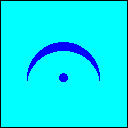 There are several symbols in music that convey
musical expression. A symbol is much preferred than some wordy directives. Symbols replace
directives which make reading easier at first glance.
There are several symbols in music that convey
musical expression. A symbol is much preferred than some wordy directives. Symbols replace
directives which make reading easier at first glance.
![]()
 A fermata may be place above or below a note
outside the musical staff. The notes marked with a
fermata are to
be held for a little longer than its actual rhythmic value. The
fermata means 'pause', and though not essential, it is appropriately placed at the end of
a musical idea.
A fermata may be place above or below a note
outside the musical staff. The notes marked with a
fermata are to
be held for a little longer than its actual rhythmic value. The
fermata means 'pause', and though not essential, it is appropriately placed at the end of
a musical idea.
 Bowed instruments have special markings to indicate
the position of the bow at particular sections in music. The 'up bow' has the arm,
carrying the bow, extended. The tip of the bow is placed on the string. The hand pushes
the bow gently over the string to produce a sound.
Bowed instruments have special markings to indicate
the position of the bow at particular sections in music. The 'up bow' has the arm,
carrying the bow, extended. The tip of the bow is placed on the string. The hand pushes
the bow gently over the string to produce a sound.
 The 'down bow' has the arm, carrying the bow,
contracted. The base of the bow is placed on the string. The hand pulls the bow over the
string to produce a sound.
The 'down bow' has the arm, carrying the bow,
contracted. The base of the bow is placed on the string. The hand pulls the bow over the
string to produce a sound.
 Instruments that support sustain pedals have symbols to
indicate up pedal and down pedal. Down pedal is represented by the symbol ped. As for up
pedal, the symbol is an asterix.
Instruments that support sustain pedals have symbols to
indicate up pedal and down pedal. Down pedal is represented by the symbol ped. As for up
pedal, the symbol is an asterix.
 A circle represents two different expressions
depending on the instrument. For string instruments, a small circle placed above a note
indicates a harmonic. A harmonic is
played by pressing firmly on a string while lightly touching a harmonic
interval higher. This will produce a glassy sounding pitch above
the actual note. This pitch may be one of many sounds of the harmonic series depending on the interval used to create it. The
circle indicates that a natural harmonic should be used. The note
is lightly pressed on one of the fundamental strings to produce an octave harmonic.
A circle represents two different expressions
depending on the instrument. For string instruments, a small circle placed above a note
indicates a harmonic. A harmonic is
played by pressing firmly on a string while lightly touching a harmonic
interval higher. This will produce a glassy sounding pitch above
the actual note. This pitch may be one of many sounds of the harmonic series depending on the interval used to create it. The
circle indicates that a natural harmonic should be used. The note
is lightly pressed on one of the fundamental strings to produce an octave harmonic.
 For brass instruments, the small circle accompanied
with the plus sign indicates whether the bell is opened or closed. The bell may be closed
with a mute or the hand. The circle means that the bell is open and the plus sign means
that the bell is closed.
For brass instruments, the small circle accompanied
with the plus sign indicates whether the bell is opened or closed. The bell may be closed
with a mute or the hand. The circle means that the bell is open and the plus sign means
that the bell is closed.
 A breath mark indicates to the performer that a
breath may be taken at that point. It functions the same as the end of a phrase mark.
A breath mark indicates to the performer that a
breath may be taken at that point. It functions the same as the end of a phrase mark.
 The octava indicates that all notes within the
dashed line are to be played an octave higher than indicated. The
octava symbol is placed above the notes on top of the musical staff.
The octava bassa indicates that all the notes within the dashed line are to be played an octave lower. The octava bassa is place under the notes below the musical staff.
The octava indicates that all notes within the
dashed line are to be played an octave higher than indicated. The
octava symbol is placed above the notes on top of the musical staff.
The octava bassa indicates that all the notes within the dashed line are to be played an octave lower. The octava bassa is place under the notes below the musical staff.
 The coda signifies a jump to a specific measure in the music designated as an ending section. The ending
section has coda marked at the beginning.
The coda signifies a jump to a specific measure in the music designated as an ending section. The ending
section has coda marked at the beginning.
 The dal segno indicates that the music is to be
repeated from the sign.
The dal segno indicates that the music is to be
repeated from the sign.